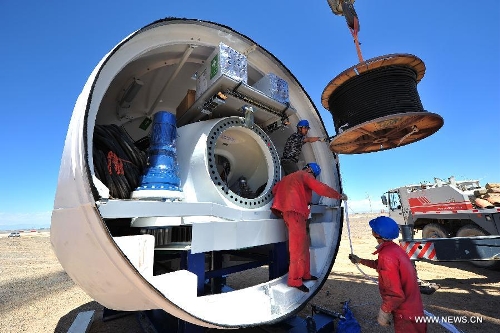Starting in 2016, on-grid tariffs for solar producers will be 0.02 to 0.10 yuan lower per kilowatt-hour – with the higher cuts applying in the country’s less populated, arid western region – while tariffs for wind power generators will fall 0.02 to 0.03 yuan, the National Development and Reform Commission said in a statement. The cuts, which were expected, are in line with a 0.03 yuan cut on Wednesday to on-grid tariffs for thermal power. Coal still fires more than 70 percent of China’s power generation.
China will cut payments to wind and solar electricity generators for contributing power to the grid, the country’s state planning commission said on Thursday, reflecting recent declines in operating costs.
“This is positive for rooftop solar,” said Rosie Pidcock, senior business development manager at UGE International, a New York-headquartered rooftop solar developer operating in China, noting the biggest impact would fall on utility-scale developers, who have mainly built solar farms in the country’s west.
The cost of installing panels was still set to fall in 2016, Pidcock said, and the cuts were not enough to push companies into the red.
China is trying to reduce its dependence on fossil fuels that are contributing to choking smog. The city of Beijing declared two pollution “red alerts” this fall.
Local governments have also been increasing the subsidies that solar producers have come to rely on, particularly in the country’s eastern half, where solar has struggled to take off.
The city of Beijing added a local subsidy for “distributed solar” – which includes rooftop and other small installations under 20 megawatts – in August, while surrounding Hebei province, the country’s biggest steel-producing region and heavy coal user, added one earlier this month. Shanghai also instituted a loan program for distributed solar this month.
China failed to meet ambitious targets for solar power last year, and re-doubled its efforts this year, calling for 23.1 gigawatts of new solar farm capacity to be installed. Less than half that was installed by end-Sept.
The country’s wind power capacity reached 113.3 GW at end-November, up from 95.8 GW last year, although in the first half of 2015, 15.2 percent of the power generated was wasted.
China will reduce benchmark on-grid price of onshore wind power and photovoltaic (PV) power generated electricity to promote a sound environment for the green energy industry, the country’s top economic planner said Thursday.
The benchmark price of onshore wind power in the first, second and third grade resource areas will be reduced by 0.02 yuan (less than one cent) in 2016 and 0.03 yuan in 2018, the National Development and Reform Commission (NDRC) said in an online statement.
The price in a fourth grade resource areas will be cut by 0.01 yuan and 0.02 yuan in 2016 and 2018, respectively, said the NDRC.
Resource area grades identify the amount of a certain resource produced in a region and help determine the price for such products. A first grade resource area would produce the most and hence generally have cheaper prices. Wind power grades range from first to fourth, while PV power ranges from first to third.
The benchmark price of PV power in the first grade resource area will be reduced by 0.1 yuan in 2016. The second and third grade resource areas will be reduced by 0.07 yuan and 0.02 yuan respectively.
The move is aimed to promote effective new energy investment and a sustainable and sound development of renewable energy industry, according to the NDRC.
The State Council released an action plan on energy development for 2014-2020 in November, promising more efficient, self-sufficient, green and innovative energy production and consumption.
By the end of 2020, China aims to increase non-fossil energy to 15 percent of total primary energy consumption and raise the share of renewable energy in production.



